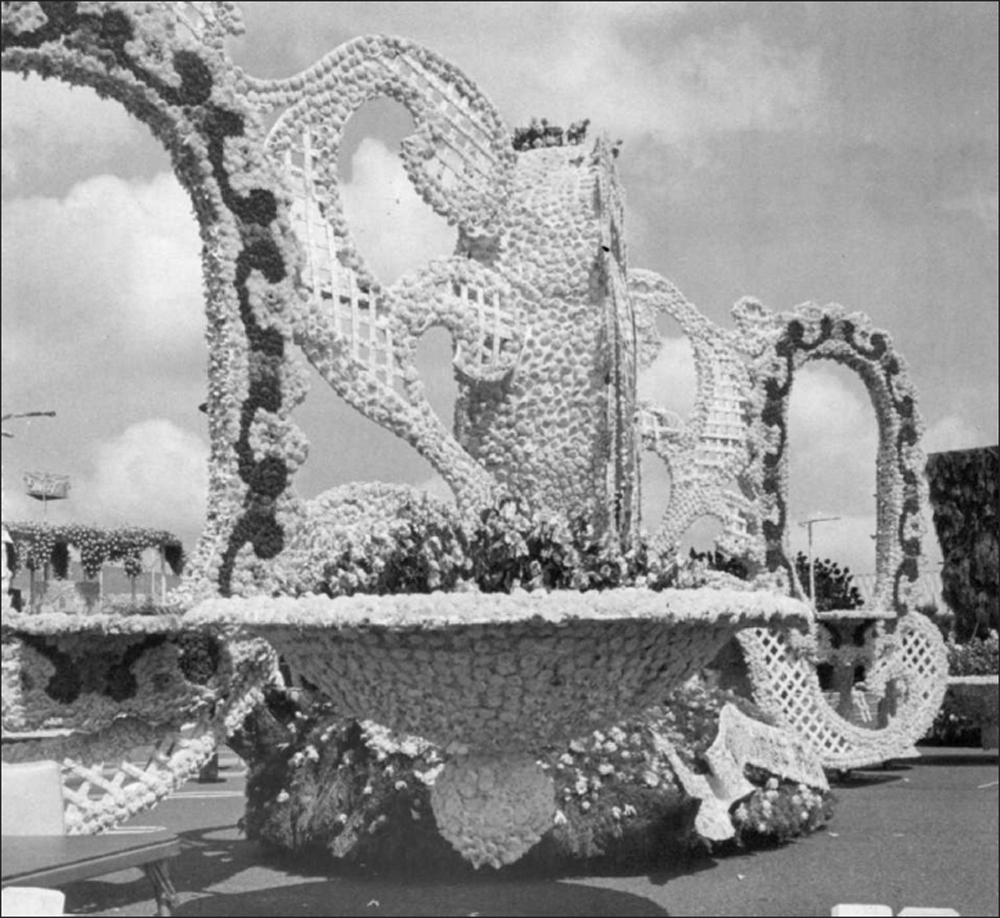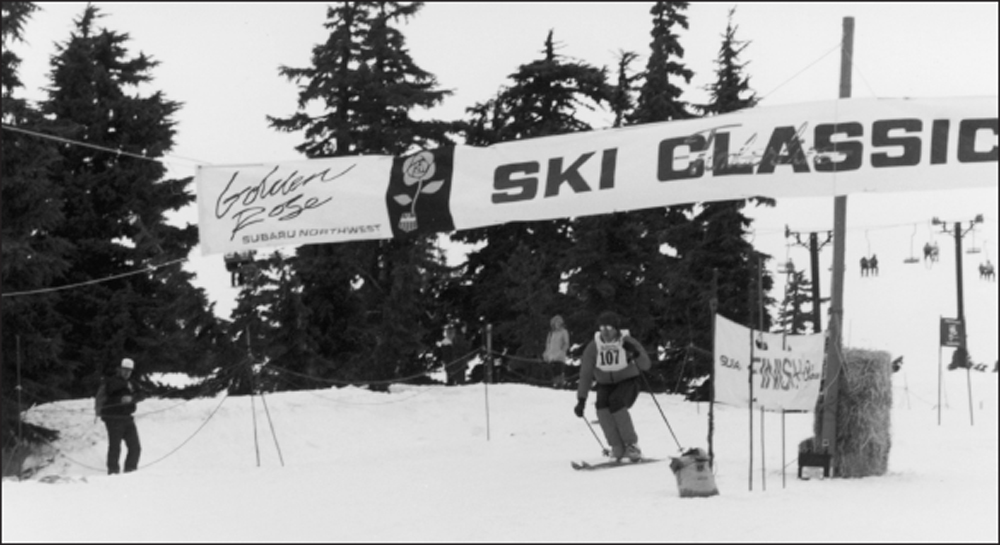Eight
1976–1983
MULTICOLORED GARDEN

The Starlight Parade, honoring the bicentennial of the United States, was introduced in 1976, replacing the waterlogged Merrykhana Parade with a colorful salute to the red, white, and blue. Ole Jupiter Pluvius slightly dampened that event as well as the Junior Parade. Plastic covering was needed as a light rain fell intermittently during the parade. Two federal geologists, Dwight Crandall and Donald Mullineaux, predicted that Mount St. Helens in Southwest Washington could blow its top “today, tomorrow or anytime between now and the year 2000.” (Courtesy Oregon Historical Society; OrgLot431,B15,F18.)

In 1977, another parade occurred during the Rose Festival, one not planned by festival officials. It was held Monday, June 6, for the Portland Trail Blazers professional basketball team. On Sunday, they defeated the Philadelphia 76ers for the NBA championship, 109 to 107. The Grand Floral Parade was held under cloudy skies with the sun breaking through at times. But it was not the weather of June that had Rose Festival officials concerned. It was the lack of rain during the winter of 1976 to 1977 that left little snowpack in the mountains. This resulted in very low water levels in both the Columbia and Willamette Rivers, which made travel treacherous for naval vessels coming to Portland for Rose Festival. (Courtesy Portland Rose Festival Foundation.)

Over the years, the Milk Carton Boat Races got fancier and more sophisticated. It was 90 degrees on Sunday, June 4, 1978. A slight east wind filled the colorful sails of some of the participants. (Courtesy Oregon Historical Photograph Archives; the Oregonian.)

Over the years, the Festival Fun Center occupied several locations. Originally in the South Park Blocks, it moved to the Holladay Park area east of the Willamette River and then to Waterfront Park. It often has the distinction of holding the key to Rose Festival financial success, drawing large crowds of young people and grown-ups. (Courtesy Portland Rose Festival Foundation.)

In 1979, the Festival Fun Center opened to sunny skies and a high temperature of 92 degrees. Ice cream and cold beverages were in demand. The theme of the Grand Floral Parade was “World Records on Parade.” Queen Rochelle Anderson and her princesses were flanked by Royal Rosarians as their float made its way down the street. Rochelle’s sister Rhonda served as the Rose Festival queen in 1969. The grand marshal of the parade was Hank Aaron, reigning Major League Baseball home run leader. In ceremonies in Washington Park, he was officially knighted on Friday, June 8. At some gas stations in Portland, gas reached 99.9¢ per gallon. (Above, courtesy Oregon Historical Society, OrHi67169; left, courtesy Oregon Historical Society, OrHi67151.)


On May 18, 1980, the beautiful Mount St. Helens in Southwest Washington erupted. The original eruption sent ash clouds over all of Eastern Washington and farther east into Idaho, Montana, and the Midwest. Logs and debris from the eruption flowed down the Toutle River, into the Cowlitz River, and then into the Columbia River, raising concerns whether the Rose Festival Fleet would be able to navigate the river. Dredges, working 24 hours a day, eventually cleared the mud and debris. (Both, courtesy the author.)


Once more, questions were raised about whether the Rose Festival should be held. It went on, including events like this traditional Rose Planting Ceremony to honor Rose Festival’s first African American queen, Robin Marks. Marks would go on to be the Fiesta Bowl queen while attending college in Arizona. Smaller eruptions continued, and one occurred just days before the Grand Floral Parade, sending a cloud of ash toward the Portland area under northeast winds. On Friday, the knighting ceremony was moved from Washington Park to the basement of the Marriott Hotel because of the threat of both rain and falling ash. Attendance at the parade itself was estimated at just over half of the prior year, and many viewers showed up along the route wearing masks. City crews had worked throughout the night to clear the worst of the wet ash from the streets. (Courtesy Oregon Historical Society; OrgLot850,B8,F6.)

The 1981 festival offered a different twist. The Royal Rosarians sponsored a church service to “call God’s blessing on the Portland Rose Festival.” It was believed to be the first such event since World War II. The service, in cooperation with Portland-area Lutheran churches, began at 1:30 p.m. on Saturday, May 30, at Peace Lutheran Church on North Portland Boulevard. The 170-voice Portland Lutheran Choral Association provided the music. June 1981 was as wet as a Portland June can get. Rainfall totaled 3.73 inches for the month, and measurable rain fell on 19 days out of the month. Dark clouds hovered over the festival. (Courtesy Oregon Historical Society; OrHi67177.)

The Festival of Bands was held in Civic Stadium, formerly Multnomah Stadium. Bands from all over the area competed. Weather sometimes complicated the event over the years. (Courtesy Oregon Historical Society; OrgLot850,B8,F3.)

Perhaps a noted television weather forecaster could change things for the 1982 Rose Festival. Willard Scott from NBC’s Today Show was selected to serve as grand marshal of the Grand Floral Parade. He did not have much luck for the start of the Fun Center, which opened on Friday, June 4. One-third inch of rain fell that day, and it was a chilly 61 degrees. (Oregon Historical Society; OrgLot850, B10, F14.)

When the Rose Festival Court visited Mount Hood for the annual Golden Rose Ski Races on Saturday, June 5, visibility ranged from good to lousy. The Junior Parade escaped the rain on Wednesday, but the Grand Floral Parade on Saturday, June 12, did not. A half-inch of rain fell on Portland that day. The rain might have been blamed on Scott, but a more likely cause was the author George Miller’s return to Portland as meteorologist in charge of the National Weather Service Forecast Office. (Oregon Historical Society; OrgLot850, B8, F12.)

The famous Clydesdales have been a welcome entry in the Portland Rose Festival for many years. These gentle giants march rain or shine. In 1982, questions were raised about the location of the Fun Center at Waterfront Park. In an unscientific survey, a majority of 126 responses indicated the event should be relocated. Thirty years later, the Fun Center—now known as Rose Festival CityFair—still occupies its home in Waterfront Park. Respondents also indicated that the Rose Festival Court should be expanded to high schools outside Portland, which finally happened in 2009. (Courtesy Oregon Historical Society; OrHi67153.)

The year 1983 marked the Silver Jubilee of the Rose Festival. The theme for the festival was, “A Backward Glance . . . A Future Dream.” Rose Festival officials had experienced three years of net losses due to factors outside their control, including the weather and the eruption of Mount St. Helens. They were looking ahead to much rosier conditions in 1983. It was cloudy for the Grand Floral Parade, but despite the threat of rain, attendance was high. (Courtesy Portland Rose Festival Foundation.)

In 1983, the Rose Festival Court, led by Queen Kira Rembold (wearing crown), made its annual visit to the Shriners Hospital for Children. The Fun Center opened on Friday, June 3, under mostly sunny skies. It was a balmy evening for the Starlight Parade on Saturday. The Junior Parade enjoyed an 80-degree day. Clouds and a little light rain returned for the Grand Floral Parade, but it did not dampen the attendance. One citizen at the parade remarked, “I think the rain bothers the parade committee more than it does the public.” (Courtesy Portland Rose Festival Foundation.)















